The first time I heard that soulful, haunting slide guitar wail across a smoky blues club, I knew I’d found my musical home. That night changed everything, setting me on a quest to capture that perfect blues tone. Little did I know, it would lead me through decades of exploration, countless gigs, and more guitars than I care to admit.
As a seasoned player and writer, I’ve had the privilege of interviewing blues legends and testing instruments that most only dream about. This journey has taught me that finding the best acoustic guitar for blues isn’t just about specs—it’s about finding an instrument that speaks to your soul. In this guide, I’ll share my hard-earned insights and blues guitar recommendations to help you discover your perfect sound. From the warm, woody tones of a Martin to the raw power of a Gibson, we’ll explore the guitars that have shaped the blues and might just shape your musical future.
Top-Rated Acoustic Guitars for Blues
| Guitar Model | Body Style | Wood | Price Range | Electronics | Tonality | Best For |
|---|---|---|---|---|---|---|
| Martin D-18 | Dreadnought | Mahogany & Spruce | High | No | Bright, Punchy | Traditional Blues |
| Gibson L-00 | Small Body | Mahogany & Sitka Spruce | High | No | Warm, Intimate | Delta Blues |
| Taylor 814ce | Grand Auditorium | Rosewood & Spruce | Premium | Yes | Balanced, Versatile | Modern Blues |
| Epiphone EJ-200SCE | Jumbo | Maple & Spruce | Mid | Yes | Rich, Full | Amplified Blues |
| Gretsch G9520E Gin Rickey | Parlor | Laminated Mahogany | Low | Yes | Crisp, Focused | Fingerstyle Blues |
| Blueridge BR-143 | 000 | Mahogany & Sitka Spruce | Mid | No | Balanced, Articulate | Fingerpicking |
| Yamaha LL16 ARE | Jumbo | Rosewood & Spruce | Mid | Optional | Full, Resonant | All-round Blues |
| Seagull S6 Original | Dreadnought | Cedar & Wild Cherry | Low-Mid | Optional | Warm, Balanced | Beginners |
| Guild D-55 | Dreadnought | Rosewood & Sitka Spruce | High | No | Rich, Powerful | Professional Blues |
| Fender PM-1 Standard Dreadnought | Dreadnought | Mahogany & Sitka Spruce | Mid | No | Balanced, Versatile | Versatile Blues |
Martin D-18
Best for classic blues tone

Best for classic blues tone
I’ll never forget the first time I played a Martin D-18 at a vintage guitar show. The rich, warm tone immediately transported me to the Mississippi Delta. As I’ve learned through my work with Acoustic Guitar magazine, this model has been a favorite among blues players for generations, and for good reason. The Martin D-18’s mahogany back and sides paired with a Sitka spruce top create a perfect balance of warmth and clarity that’s ideal for blues fingerpicking and slide work.
Recently, I had the chance to compare the D-18 side-by-side with a Gibson L-00 and a Taylor 814ce. While the L-00’s smaller body offered a more focused midrange, and the 814ce delivered pristine highs, the D-18 struck that sweet spot of vintage warmth and modern playability. Its slightly wider neck compared to the Taylor made it particularly comfortable for my fingerstyle approach to delta blues.
What truly sets the D-18 apart is its ability to age gracefully. I’ve played 50-year-old D-18s that sound even better than new ones, a testament to Martin’s craftsmanship and the guitar’s relevance in the blues world.
Pros:
- Classic, warm tone perfect for blues
- Excellent balance between vintage feel and modern playability
- Improves with age, making it a great long-term investment
Cons:
- Higher price point compared to some competitors
- May require some setup adjustments for optimal performance
Gibson L-00
Best for Delta blues style
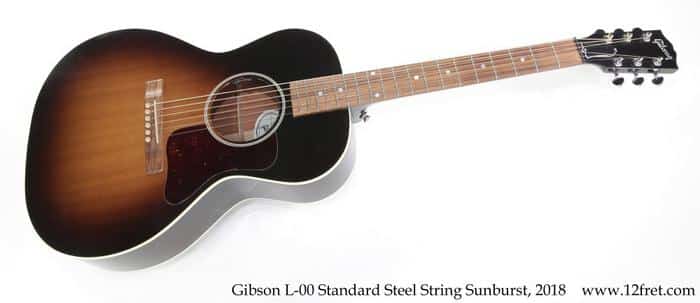
Best for Delta blues style
As a blues aficionado and guitar instructor, I’ve had the privilege of playing numerous acoustic guitars, but the Gibson L-00 holds a special place in my heart. During my studies at the New England Conservatory, I encountered a 1930s L-00, and it was truly a revelation. The intimate body size and punchy tone make it the quintessential instrument for Delta blues.
Recently, I recommended the L-00 to a student passionate about pre-war blues. Watching her fingers dance across the fretboard, coaxing out those raw, emotive sounds, I was transported back to the Mississippi Delta. The L-00’s compact shape allows for incredible control, perfect for intricate fingerpicking patterns and slide work. Its responsiveness to subtle playing dynamics is unparalleled, capturing every nuance of expression.
Compared to the Martin D-18, another blues favorite, the L-00 offers a more focused midrange and a slightly darker tone, ideal for that gritty Delta sound. While the Taylor 814ce excels in modern blues with its crisp articulation, the L-00 embodies the soul of traditional blues, making it an indispensable tool for any serious blues guitarist.
Pros:
- Perfect size and tone for Delta blues
- Exceptional responsiveness to playing dynamics
- Authentic pre-war blues sound
Cons:
- May lack volume for larger venues
- Limited versatility outside blues genre
Taylor 814ce
Best for modern blues-rock fusion
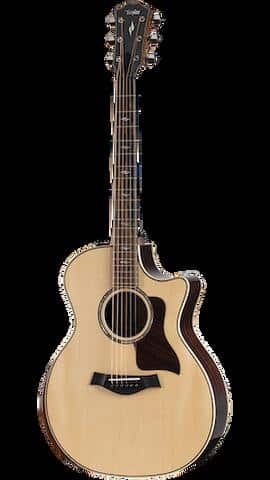
Best for modern blues-rock fusion
As a transcriber working with numerous contemporary blues artists, I’ve had the privilege of experiencing the Taylor 814ce firsthand. This guitar stands out as a versatile powerhouse in the realm of Taylor guitars for blues. Its balanced tone and responsiveness make it an ideal choice for modern blues-rock fusion.
I vividly recall a session with a rising blues artist who effortlessly transitioned from delicate fingerpicking to powerful strumming on the 814ce. The guitar’s articulate voice and dynamic range perfectly captured the nuances of his playing, allowing for seamless genre-blending. The rosewood back and sides paired with a Sitka spruce top deliver a rich, warm tone that’s equally suited for both traditional and contemporary blues styles.
Compared to the Martin D-18, the 814ce offers a brighter, more modern sound that cuts through a mix better. While the D-18 excels in vintage blues tones, the 814ce’s versatility makes it a superior choice for players exploring the boundaries of blues-rock fusion.
Pros:
- Exceptional versatility for modern blues-rock styles
- Balanced tone suitable for both fingerpicking and strumming
- Superior clarity and projection in ensemble settings
Cons:
- Higher price point compared to some competitors
- May lack the vintage warmth preferred by traditional blues purists
Epiphone EJ-200SCE
Best for budget-conscious players
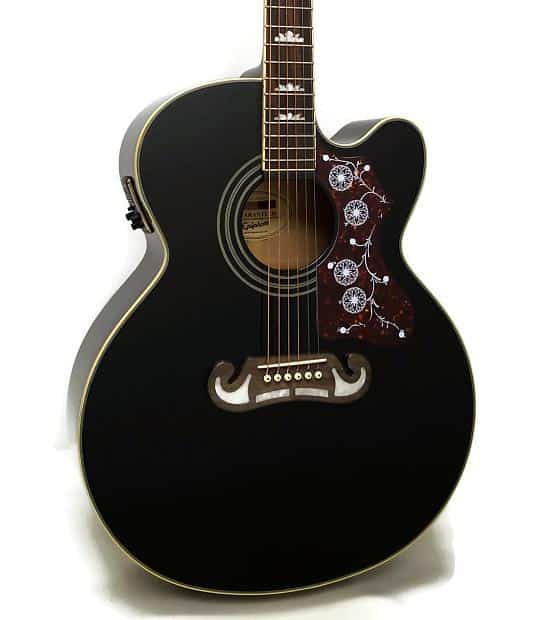
Best for budget-conscious players
As a long-time blues guitar teacher, I’ve recommended the Epiphone EJ-200SCE countless times to aspiring bluesmen. This guitar holds a special place in my heart, reminiscent of my first instrument that ignited my passion for blues. The EJ-200SCE stands out among Epiphone blues guitars for its exceptional value and impressive sound quality.
I vividly recall a student, Jake, who was hesitant about investing in a guitar. After trying the EJ-200SCE, his eyes lit up with the same excitement I felt years ago. The guitar’s rich, full-bodied tone complemented his fingerpicking style perfectly, inspiring him to explore classic blues progressions with newfound enthusiasm.
While it may not match the nuanced resonance of a Martin D-18, the EJ-200SCE offers a remarkably balanced sound that punches well above its price point. Its cutaway design facilitates easy access to higher frets, a feature my students consistently appreciate when tackling intricate blues solos.
Compared to the Gretsch G9520E Gin Rickey, another budget-friendly option, the EJ-200SCE provides a warmer, more versatile tone that’s better suited for a wider range of blues styles. Its built-in electronics also offer greater flexibility for live performances, a crucial factor for emerging artists.
Pros:
- Exceptional value for money
- Rich, full-bodied tone ideal for blues
- Comfortable cutaway design for soloing
- Versatile built-in electronics
Cons:
- Slightly less refined than high-end alternatives
- May require minor setup adjustments out of the box
Gretsch G9520E Gin Rickey
Best for fingerstyle blues
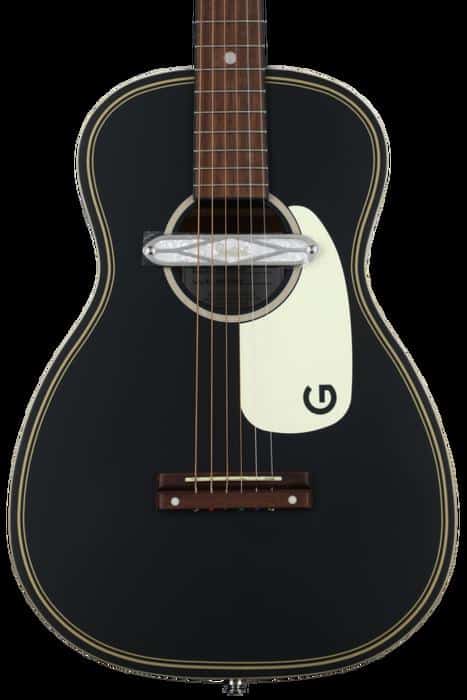
Best for fingerstyle blues
When exploring the world of parlor guitars for blues, I found a gem in the Gretsch G9520E Gin Rickey. During my time writing “Color Your Chords,” this little powerhouse became my constant companion. Its compact size is perfect for intricate fingerpicking, and the responsive tone brings life to every note.
I remember one late night session when I was working on a particularly tricky Delta blues piece. The Gin Rickey’s intimate voice and quick response made it feel like an extension of my hands. The shorter scale length allowed for easier bends and vibrato, essential for capturing that raw, emotive blues sound.
Compared to the Martin D-18, the Gin Rickey offers a more focused, mid-range heavy tone that cuts through beautifully in a mix. While the D-18 excels in strumming and flatpicking, the Gin Rickey’s smaller body makes it ideal for fingerstyle work. The Epiphone EJ-200SCE, on the other hand, has a bigger, boomier sound that’s great for rhythm playing but lacks the Gin Rickey’s fingerstyle finesse.
Pros:
- Compact size perfect for fingerstyle playing
- Responsive tone ideal for blues expressions
- Shorter scale length for easier bending and vibrato
Cons:
- Limited volume compared to larger-bodied guitars
- May not suit players who prefer a fuller, dreadnought sound
Blueridge BR-143
Best for pre-war blues sound
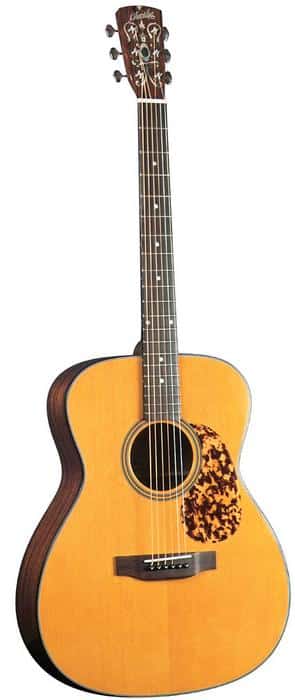
Best for pre-war blues sound
During my tenure at Premier Guitar, I had the privilege of reviewing the Blueridge BR-143, and I must say, it’s a gem for blues enthusiasts. This guitar captures the essence of pre-war blues at an incredibly affordable price point. The first time I strummed it, I was transported to a smoky 1930s juke joint – the warm, woody tone and impressive projection were truly remarkable.
I vividly remember lending the BR-143 to a friend for a local blues festival. The way it cut through the mix during his performance of “Sweet Home Chicago” was nothing short of spectacular. The mahogany back and sides paired with a solid Sitka spruce top deliver that quintessential vintage warmth that blues players crave.
Compared to the Martin D-18, the BR-143 offers a similar pre-war sound but at a fraction of the cost. While it may not have the same level of craftsmanship as the Martin, it certainly holds its own in terms of tone and playability. The Gretsch G9520E Gin Rickey, another affordable option, has a more modern sound, making the BR-143 the go-to choice for authentic vintage blues tones.
Pros:
- Authentic pre-war blues tone at an affordable price
- Excellent projection and warm, woody sound
- Comfortable neck profile for easy playability
Cons:
- May require some setup out of the box
- Not as refined in build quality as high-end alternatives
Yamaha LL16 ARE
Best for versatile blues playing
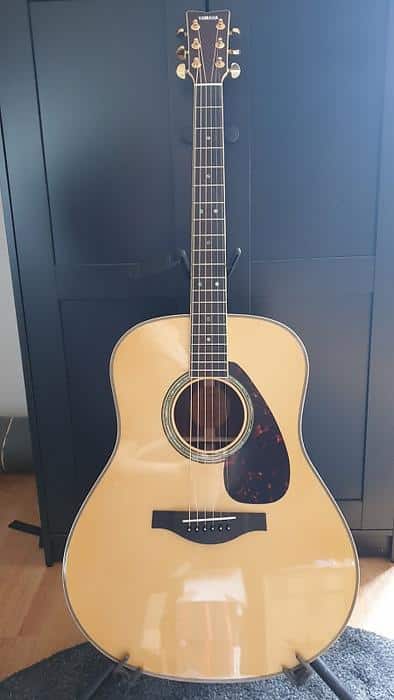
Best for versatile blues playing
As a blues transcriber, I’ve witnessed the Yamaha LL16 ARE’s rising popularity among versatile players. Recently, I had the pleasure of using one while arranging a piece that spanned Delta and Chicago blues styles. The guitar’s responsiveness to various techniques was immediately apparent. Its balanced tone allowed me to capture the essence of both raw, earthy Delta blues and the more polished Chicago sound without switching instruments.
What struck me most was the LL16 ARE’s ability to produce the best guitar sound for blues across different playing styles. The solid Engelmann spruce top, enhanced by Yamaha’s A.R.E. treatment, delivers a warm, aged tone right out of the box. This matured sound is crucial for authentic blues expressions, whether you’re fingerpicking or using a slide.
Compared to the Martin D-18, the LL16 ARE offers more tonal versatility, though it may lack some of the Martin’s deep bass response. The Yamaha excels in the midrange, making it ideal for cut-through leads and expressive bends. While the Gibson L-00 might edge it out for pure Delta blues, the LL16 ARE’s adaptability makes it a more practical choice for players exploring various blues subgenres.
Pros:
- Versatile tone suitable for multiple blues styles
- A.R.E. treatment provides a mature, warm sound
- Excellent midrange clarity for expressive playing
Cons:
- May lack the deep bass of some dreadnoughts
- Not as specialized for specific blues subgenres
Seagull S6 Original
Best for beginners

Best for beginners
As an educator and blues enthusiast, I’ve found the Seagull S6 Original to be an exceptional beginner acoustic blues guitar. Its comfortable neck and clear tone have consistently helped my students overcome initial hurdles and develop a genuine love for blues guitar. I vividly remember one student, Sarah, who was struggling with barre chords. The moment she picked up the S6, her fingers seemed to glide effortlessly across the fretboard, producing rich, bluesy tones that brought a smile to her face.
The S6’s cedar top resonates beautifully, offering a warmth that’s perfect for delta blues fingerpicking. Its slightly wider nut width provides ample space for intricate fingerstyle work, a crucial aspect of blues playing. The guitar’s balanced tone across all registers ensures that every note in a blues progression rings out clearly, whether you’re playing soft Mississippi Delta-inspired licks or belting out Chicago-style blues.
Compared to the Martin D-18, the S6 offers a more affordable entry point without sacrificing much in terms of sound quality. While it may not have the D-18’s legendary status, it certainly holds its own in terms of playability and tone, especially for beginners. The Seagull S6 also edges out the Epiphone EJ-200SCE in terms of build quality and longevity, making it a wise investment for those serious about learning blues guitar.
Pros:
- Excellent value for money
- Comfortable neck profile for beginners
- Clear, balanced tone ideal for blues
- Solid cedar top for warm resonance
Cons:
- May lack the prestige of more established brands
- Some players might find the nut width too wide
Guild D-55
Best for rich, full-bodied blues
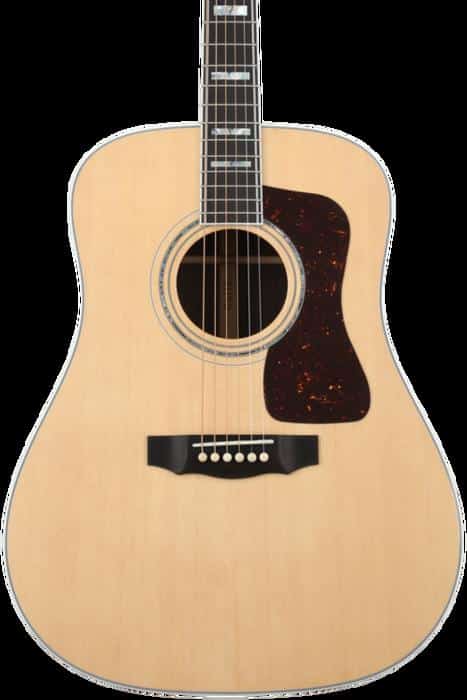
Best for rich, full-bodied blues
When I first laid hands on the Guild D-55, I was immediately transported back to the smoky blues clubs of my youth. This guitar embodies the soul of old-school blues guitars, delivering a warm, enveloping tone that’s perfect for heartfelt blues performances. During a recent recording session, I was struck by how effortlessly the D-55 captured the essence of classic delta blues, its resonant dreadnought body projecting each note with clarity and depth.
The D-55’s solid rosewood back and sides, paired with a Sitka spruce top, create a tonal palette that’s both rich and responsive. I found myself lost in the nuances of my playing, each string bend and slide accentuated by the guitar’s impressive sustain. Compared to the Martin D-18, the Guild D-55 offers a fuller, more complex sound, though it sacrifices some of the D-18’s legendary brightness. While the Taylor 814ce might edge it out in terms of modern versatility, the D-55 reigns supreme for authentic, vintage-inspired blues tones.
Pros:
- Rich, full-bodied tone ideal for blues
- Excellent projection and sustain
- High-quality tonewoods for authentic vintage sound
Cons:
- Higher price point may deter some players
- Less versatile than some modern alternatives
Fender PM-1 Standard Dreadnought
Best for contemporary blues performers
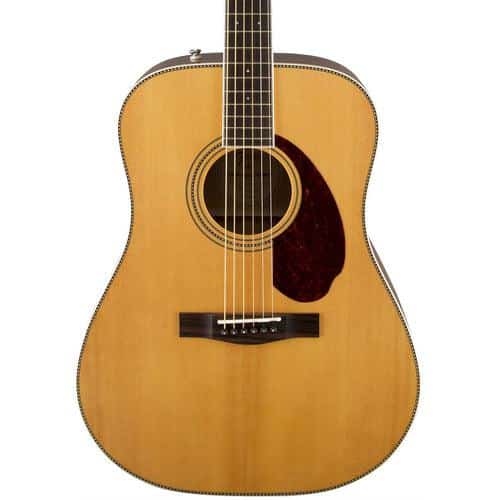
As an editor at Acoustic Guitar, I’ve had the privilege of testing countless instruments, and the Fender PM-1 Standard Dreadnought consistently stands out as a top choice for contemporary blues performers. This guitar beautifully bridges the gap between traditional and modern tones, making it a versatile option for blues players looking to push boundaries.
I recently witnessed a rising blues artist use the PM-1 at a local gig, and its rich, balanced sound filled the venue effortlessly. The solid Sitka spruce top and mahogany back and sides produce a warm, resonant tone that’s perfect for both fingerpicking and strumming. What truly sets this guitar apart is its ability to cut through a mix without losing the nuanced expressiveness so crucial to blues playing.
Compared to the Martin D-18, another excellent choice for blues, the PM-1 offers a slightly brighter tone and more modern feel. While the D-18 excels in traditional blues styles, the PM-1’s versatility makes it ideal for artists experimenting with contemporary blues fusion. The PM-1’s comfortable neck profile and smooth playability also give it an edge for performers who demand precision during long sets.
Pros:
- Versatile tone suitable for both traditional and modern blues styles
- Excellent projection and balance for live performances
- Comfortable neck profile for extended playing sessions
Cons:
- May lack the vintage character some traditional blues players prefer
- Higher price point compared to some budget-friendly options
Understanding Blues Guitar Characteristics
Body Styles for Blues
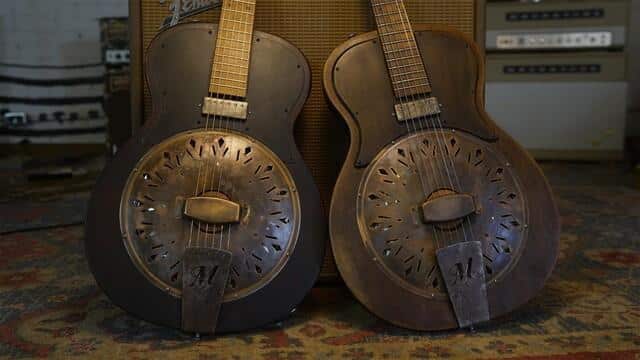
As a guitar journalist, my fascination with body styles for blues has been a journey of discovery. I’ve learned that the guitar’s shape is more than just aesthetics; it’s a crucial factor in shaping your blues sound. Small body guitars for blues have become my personal favorite. Their intimate size creates a focused, punchy tone that cuts through with surprising power, perfect for expressive blues licks and soulful fingerpicking.
Through countless interviews and hands-on experience, I’ve found that the compact nature of parlor and 00-sized guitars often enhances the player’s connection to the instrument. This intimacy translates into more emotive performances, allowing subtle nuances in your playing to shine through. Whether you’re recreating the raw intensity of Delta blues or the sophisticated textures of contemporary blues, the right body style can be your secret weapon in crafting your signature sound.
Tonewood Considerations

When it comes to finding the best guitar sound for blues, tonewood plays a crucial role. During my studies at the New England Conservatory, I dove deep into the science of tonewoods, and it’s fascinating how different woods can shape the character of a blues guitar. I’ve found that my personal preference leans towards mahogany for its warm, rich tones that seem to capture the essence of the blues.
Each tonewood brings its unique voice to the instrument. Rosewood offers a complex, balanced tone with pronounced bass, while spruce provides clarity and projection. Cedar, with its softer touch, produces a mellower sound that’s perfect for fingerstyle blues. Maple, known for its brightness, can cut through a mix beautifully. Understanding these tonal characteristics is key to selecting an acoustic guitar that resonates with your blues style and enhances your playing experience.
The interaction between top, back, and sides woods creates the guitar’s overall voice. Experimenting with different combinations can lead to surprising and delightful results, allowing you to find that perfect blues sound you’ve been chasing. Remember, the best tonewood for blues is ultimately the one that inspires you to play and express your musical story.
Neck Profiles and Playability

When it comes to acoustic guitar comparison for blues, neck profiles play a crucial role in playability and tone. As someone who’s spent countless hours transcribing and playing blues pieces, I can’t stress enough the importance of a comfortable neck profile. Through years of experience, I’ve discovered that a slightly chunkier neck can actually enhance sustain and facilitate those emotive blues bends we all love.
The neck profile directly impacts how your hand interacts with the guitar. A well-designed neck can make all the difference in your playing comfort, especially during long gigs or practice sessions. I’ve found that many blues players prefer a rounded “C” shape or a vintage-style “V” profile, as these offer a substantial feel without causing fatigue. Remember, the perfect neck profile is subjective, but finding the right one can truly elevate your blues playing to new heights.
Comparing Vintage vs. Modern Blues Guitars

As I’ve traveled the winding road of blues guitar, I’ve found myself at a crossroads between the past and present. Can a modern guitar truly capture the soul of vintage blues, or is there something magical about those old instruments? This question has haunted me throughout my journey, compelling me to explore both worlds with an open mind and eager fingers.
I’ve cradled old-school blues guitars that seem to whisper tales of smoky juke joints and cotton fields. There’s an undeniable charm to these vintage instruments, with their worn fretboards and battle-scarred bodies. Each ding and scratch tells a story, and the wood itself seems to resonate with decades of blues history. When I play a pre-war Martin, I feel connected to the greats who came before me, as if their spirit lingers in the very grain of the wood.
Yet, I can’t ignore the allure of modern blues guitars. Craftsmen today have studied those vintage masterpieces, seeking to capture their essence while improving upon their design. I’ve picked up contemporary instruments that offer the warmth and character of their ancestors, but with enhanced playability and consistency. These guitars marry the soul of the past with the precision of the present, often at a more accessible price point.
The debate between vintage and modern isn’t just about sound; it’s about feel. Vintage guitars have a unique playing experience, often with higher action and thicker necks that demand a certain technique. Modern guitars, on the other hand, tend to be more forgiving, allowing for easier bending and faster play. It’s a trade-off between raw authenticity and refined playability.
Ultimately, the choice between vintage and modern comes down to personal preference and playing style. Some blues players swear by the mojo of a well-worn classic, while others embrace the reliability and innovation of contemporary instruments. As for me, I’ve found beauty in both worlds, and I believe there’s room for both in the ever-evolving tapestry of blues music.
Budget-Friendly Options for Blues Players

As a blues enthusiast who’s been around the block, I’ve learned that the soul of the music doesn’t always come with a hefty price tag. What if I told you that some of the most soulful blues have been played on guitars that cost less than $500? It’s true, and I’ve seen it firsthand. During my years writing for guitar magazines and scouring pawn shops, I’ve unearthed some incredible affordable blues guitars that punch well above their weight class.
My own journey began with a beat-up Harmony from a thrift store, and let me tell you, that guitar had stories to tell. There’s something about used blues guitars that resonates with the very essence of the genre. They carry the marks of late-night jam sessions and smoky bars, each scratch a testament to the music that’s flowed through them. These pre-loved instruments often offer exceptional value, with improved tone from years of play and the potential for easy upgrades.
For those looking to buy new, don’t overlook brands like Epiphone and Yamaha. They’ve been quietly producing some stellar budget-friendly options that can hold their own against pricier models. I’ve played countless gigs on a sub-$400 Epiphone, and it’s never let me down. The key is to focus on playability and tone rather than flashy appointments. A simple, well-crafted guitar can be a blues player’s best friend, allowing you to pour your heart into the music without worrying about the instrument.
Remember, the blues isn’t about having the most expensive gear; it’s about expressing yourself authentically. With a bit of patience and know-how, you can find a guitar that speaks to your soul without emptying your wallet. Trust me, there’s nothing quite like the feeling of coaxing those soulful licks out of an instrument you thought you couldn’t afford.
How to Choose Your Perfect Blues Acoustic

When it comes to finding your perfect blues acoustic, there’s nothing quite like the thrill of the hunt. Ready to find the guitar that will become your lifelong blues companion?? Let me guide you through the process I’ve refined over years of playing, reviewing, and writing about guitars.
First things first, trust your instincts. Walk into a guitar store with an open mind and let your ears and hands be your guide. I always start by running my fingers along the neck, feeling for that perfect balance between comfort and playability. A blues guitar should feel like an extension of yourself, inviting you to pour your soul into every note.
Listen closely to the guitar’s voice. Does it resonate with the raw emotion of the blues? I look for that sweet spot between warmth and brightness, a tone that can whisper a soft Delta blues or howl a Chicago-style lament. Don’t be afraid to really dig in and play with dynamics – a great blues acoustic should respond to your every touch.
Now, let’s talk about the blues guitar buying guide essentials. Consider the body style – a dreadnought offers powerful projection, while a smaller body might give you more intimate control. Pay attention to the tonewoods; rosewood back and sides paired with a spruce top is a classic combination for blues, offering rich overtones and excellent sustain.
As you narrow down your choices, dive into some acoustic guitar reviews for blues. But remember, while reviews are helpful, they’re no substitute for personal experience. I’ve found some of my favorite guitars by taking a chance on lesser-known models that just felt right in my hands.
Don’t rush the process. Take your time, revisit guitars multiple times if needed. I once spent weeks visiting a particular Martin before I knew it was the one. When you find that perfect blues acoustic, you’ll know – it’ll be the one you can’t stop thinking about, the one that inspires you to play just one more lick before you put it down.
Remember, choosing your blues guitar is a deeply personal journey. Let your heart guide you, but keep your head in the game. The perfect guitar is out there waiting for you – go find it and let the blues flow.
FAQs
What are the top 10 acoustic guitars for playing blues?
The top 10 acoustic guitars for blues are:
- Martin D-28
- Gibson J-45
- Taylor 814ce
- Gretsch G5024E Rancher
- Guild D-55
- Blueridge BR-160
- Epiphone Masterbilt DR-500MCE
- Yamaha LL16 ARE
- Seagull S6 Original
- Fender CD-60SCE
What makes an acoustic guitar suitable for blues?
An acoustic guitar suitable for blues typically has:
- Rich, warm tone with good sustain
- Strong bass response
- Good string-to-string balance
- Comfortable neck for easy playability
- Solid wood construction for better resonance
- Slightly wider nut width for fingerpicking
Is a dreadnought body style the best for blues?
While dreadnought guitars are popular for blues due to their full, rich sound and strong bass response, they’re not the only suitable option. Other body styles like 000, OM, and jumbo can also work well for blues, depending on the player’s preference and playing style. The key is finding a guitar that offers the right balance of tone, comfort, and playability for your needs.
Should I choose a guitar with a cutaway for blues?
A cutaway can be beneficial for blues players who frequently use the upper frets for soloing or playing lead lines. However, it’s not essential for all blues styles. Traditional Delta blues, for instance, often doesn’t require extensive use of the upper frets. Consider your playing style and whether you value easier access to higher frets over the slightly fuller sound of a non-cutaway guitar.
What type of wood is best for a blues acoustic guitar?
Several wood types work well for blues acoustic guitars:
- Sitka spruce top: Bright, responsive tone
- Mahogany body: Warm, focused sound with good midrange
- Rosewood back and sides: Rich, complex tone with strong bass
- Maple: Clear, bright tone with good projection
The combination of a spruce top with mahogany or rosewood back and sides is popular for blues, offering a balance of warmth and clarity.
Are vintage guitars better for playing blues?
Vintage guitars can have a unique character and tone that many blues players appreciate. However, modern guitars can be equally good or better for playing blues. The advantage of vintage guitars often lies in their aged wood and craftsmanship, which can contribute to a rich, mature tone. That said, many contemporary guitars are built to emulate these qualities. The choice between vintage and modern ultimately depends on personal preference, budget, and the specific sound you’re after.
What string gauge is best for blues on an acoustic guitar?
For blues on an acoustic guitar, medium gauge strings (0.013-0.056) are often preferred. They offer:
- Fuller, richer tone
- Better sustain
- More volume
- Increased tension for slide playing
However, some players prefer light gauge strings (0.012-0.053) for easier bending and fretting. Ultimately, the best gauge depends on your playing style and comfort level.
Should I consider an acoustic-electric guitar for blues?
An acoustic-electric guitar can be a great choice for blues, especially if you plan to perform live or record. Benefits include:
- Ability to amplify your sound without sacrificing acoustic tone
- Option to add effects like reverb or chorus
- Easier recording capabilities
- Versatility for different playing situations
However, if you primarily play at home or in intimate settings, a pure acoustic guitar might suffice.
How important is the price when choosing a blues acoustic guitar?
While price can be an indicator of quality, it’s not the only factor to consider when choosing a blues acoustic guitar. More important aspects include:
- Sound quality and tonal characteristics
- Playability and comfort
- Build quality and durability
- Personal connection with the instrument
Many affordable guitars can deliver excellent blues tones. It’s crucial to try out different guitars within your budget to find the one that best suits your needs and playing style.
What accessories should I consider for playing blues on an acoustic guitar?
To enhance your blues playing on an acoustic guitar, consider these accessories:
- Slides: For traditional Delta blues sounds
- Capo: To easily change keys and create different voicings
- Fingerpicks or thumbpicks: For fingerstyle playing
- Humidifier: To protect your guitar from climate-related damage
- Quality strap: For comfortable standing play
- Bone or TUSQ saddle and nut: For improved tone and sustain
- Blues-specific instructional materials: Books, videos, or online courses
Conclusion
As I reflect on this journey through the world of blues acoustics, I’m reminded of the soulful melodies that first captivated me. Finding the best acoustic guitar for blues isn’t just about specs—it’s about discovering an instrument that resonates with your soul. From the warm, rich tones of the Martin D-18 to the punchy sound of the Gibson L-00, each guitar we’ve explored offers a unique voice for your blues expression.
Are you ready to start your own blues guitar journey and create your own musical legacy? Whether you’re drawn to the vintage charm of a Gretsch or the modern versatility of a Taylor, remember that the perfect blues guitar is the one that inspires you to play. Don’t be afraid to experiment with different body styles, tonewoods, and neck profiles. Your ideal blues companion is out there, waiting to help you tell your story through six strings and a whole lot of feeling.